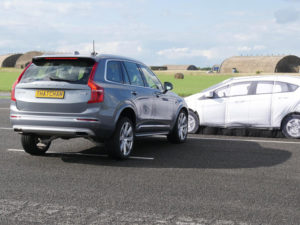New safety tech to be mandated by EU
Advanced safety features such as autonomous emergency braking (AEB) and intelligent speed assistance (ISA) will be fitted as standard on new cars by 2021 under new European Commission plans.

The latest vehicle safety measures would see AEB mandated by 2021
Part of a package of measures to drive road safety, the proposals would see 11 different systems, also including alcohol interlock installation facilitation, drowsiness and attention detection and accident data recorders, be required on new cars within the next three years. Currently these features are only available as an option on some models. Bar AEB, all of the technologies would be standard on vans too while trucks and buses would also get various safety features including a focus on vulnerable road user detection.
In addition, as part of its so-called third mobility package, the European Commission also published an overall outline of the road safety strategy for the decade to 2030 – including setting a new EU target to halve road deaths, and for the first time, serious injuries in the decade to 2030 – and updated rules on road infrastructure safety management and a strategy for automated driving.
The news was welcomed by the European Transport Safety Council. Executive director Antonio Avenoso said: “Taken together, today’s announcements could represent the biggest step forward in road safety in Europe since the introduction of the seat belt. Road traffic injury is still the number one killer of young people across the continent so these essential measures cannot come soon enough.
“Today’s announcements alone will not make the difference; it is absolutely crucial that EU Member States and the European Parliament give their backing to the plans and that they do not give in to pressure from car manufacturers, who are already attempting to weaken parts of the vehicle safety proposal.”
The European Automobile Manufacturers’ Association (ACEA) said it welcomed the proposals on vehicle safety technologies but stressed that some proposed measures would require further review to ensure a focus on the most effective solutions with the strongest positive outcome.
ACEA secretary general Erik Jonnaert said: “Vehicle technology is just one piece of the complex safety puzzle. If we are to make progress on the Commission’s new objective of reducing fatalities and serious injuries by half between 2020 and 2030, we need put more emphasis on an integrated road safety strategy. This is the only way to ensure that safe vehicles are driven by safe drivers on safe roads.”
As such, the organisation welcomed the updated rules on road infrastructure safety, as well as a strategy for automated driving.
List of proposed mandatory new safety features:
- Advanced emergency braking (cars)
- Alcohol interlock installation facilitation (cars, vans, trucks, buses)
- Drowsiness and attention detection (cars, vans, trucks, buses)
- Distraction recognition / prevention (cars, vans, trucks, buses)
- Event (accident) data recorder (cars and vans)
- Emergency stop signal (cars, vans, trucks, buses)
- Full-width frontal occupant protection crash test – improved seatbelts (cars and vans)
- Head impact zone enlargement for pedestrians and cyclists -safety glass in case of crash (cars and vans)
- Intelligent speed assistance (cars, vans, trucks, buses)
- Lane keeping assist (cars, vans)
- Pole side impact occupant protection (cars, vans)
- Reversing camera or detection system (cars, vans, trucks, buses)
- Tyre pressure monitoring system (vans, trucks, buses)
- Vulnerable road user detection and warning on front and side of vehicle (trucks and buses)
- Vulnerable road user improved direct vision from driver’s position (trucks and buses)

